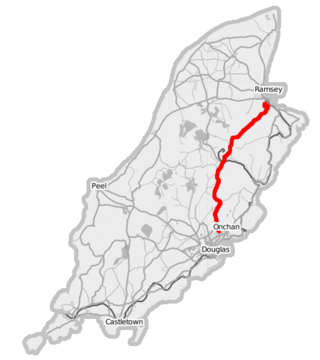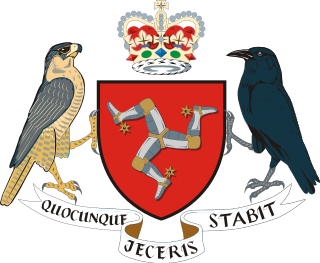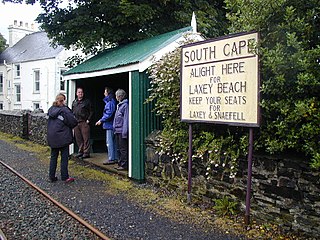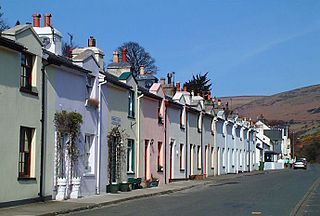
Laxey is a village on the east coast of the Isle of Man. Its name derives from the Old Norse Laxa meaning 'Salmon River'. Its key distinguishing features are its three working vintage railways and the largest working waterwheel in the world. It is also the location of King Orry's Grave.

The Manx Electric Railway is an electric interurban tramway connecting Douglas, Laxey and Ramsey in the Isle of Man. It connects with the Douglas Bay Horse Tramway at its southern terminus at Derby Castle at the northern end of the promenade in Douglas, and with the Snaefell Mountain Railway at Laxey. Many visitors take an excursion on the trams. It is the oldest electric tram line in the world whose original rolling stock is still in service.

The Snaefell Mountain Railway is an electric mountain railway on the Isle of Man in Europe. It joins the village of Laxey with the summit of Snaefell, at 2,036 feet (621 m) above sea level the highest point on the island. It connects with the Manx Electric Railway (MER) in Laxey. The line is 5 miles (8 km) long, is built to 3 ft 6 in gauge and uses a Fell Incline Railway System centre rail for braking on the steep gradients. It is electrified using overhead wires at 550 volts direct current, with bow collectors.

Snaefell – is the highest mountain and the only summit above 2,000 feet (610 m) on the Isle of Man, at 2,037 feet (620.9 m) above sea level. The summit is crowned by a railway station, cafe, several communications masts and can be reached by narrow gauge railway.

Manx National Heritage is the national heritage organisation for the Isle of Man. The organisation manages a significant proportion of the Island’s physical heritage assets including over 3,000 acres of coastline and landscape. It holds property, archives, artwork, library and museum collections in trust for the Manx nation. It is the Isle of Man's statutory heritage agency and an Isle of Man registered charity (№ 603).

The Great Laxey Mine Railway was originally constructed to serve the Isle of Man's Great Laxey Mine, a lead mine located in Laxey. The 19 in gauge railway runs from the old mine entrance to the washing floors along a right of way that passes through the Isle of Man's only remaining railway tunnel under the 3 ft gauge Victorian Manx Electric Railway and the main A2 Douglas to Ramsey coast road.

The A18 Snaefell Mountain Road or Mountain Road is a primary main A-road of 13.35 miles (21.48 km) in length which connects the towns of Douglas and Ramsey in the Isle of Man.

The Snaefell Wheel is a waterwheel in Laxey, Isle of Man. The wheel stands in the washing floors in Laxey Glen Gardens, approximately 700 metres south of the larger Laxey Wheel.

Isle of Man Public Transport also known as Isle of Man Transport and Isle of Man Transport Services, is a division of the Isle of Man Government's Department of Infrastructure that operates public transport on the Isle of Man.

The Groudle Glen Water Wheel unofficially known by the sobriquet of Little Isabella is a rustic water wheel, situated in Groudle Glen on the Isle of Man, that was originally built in 1893 with the arrival of the Manx Electric Railway to the glen.

South Cape Halt is an intermediate stopping place on the easterly section of the Manx Electric Railway on the Isle of Man.

Dumbell's Row is an intermediate stopping place on the Manx Electric Railway on the Isle of Man and is the first station on the northern section of the line from Laxey, which opened in 1899.

The Great Snaefell Mine, also referred to as the East Snaefell Mine, was a zinc mine located high in the Laxey Valley on the slopes of Snaefell Mountain, in the parish of Lonan, Isle of Man. The mine reached a depth of 1,188 ft (362 m) and is remembered as the scene of the Isle of Man's worst mining disaster in 1897.

The Great Laxey Mine was a silver, lead ore and zinc mine located in Laxey, in the parish of Lonan, Isle of Man. The mine reached a depth in excess of 2,200 ft (670 m) and consisted primarily of three shafts: the Welsh Shaft, the Dumbell's Shaft and the Engine Shaft; each of these shafts was connected by a series of levels.
The Ballajora Mine also referred to as the Maughold Head Mine, was an iron ore, hematite and copper mine located in the parish of Maughold, Isle of Man. The mine lay principally on the farmland of Magher-beck. The head engineer of the mine, referred to as the Mine Captain, was John Faragher.
The Maughold Head Mine was a copper mine located in the parish of Maughold, Isle of Man.
The Dhyrnane Mine was a hematite and iron ore mine located in the parish of Maughold, Isle of Man.

The Foxdale Mines is a collective term for a series of mines and shafts which were situated in a highly mineralised zone on the Isle of Man, running east to west, from Elerslie mine in Crosby to Niarbyl on the coast near Dalby. In the 19th century the mines were widely regarded as amongst the richest ore mines in the British Isles.

John Kewley was Captain of the Great Snaefell Mine, Isle of Man. He is remembered for his heroism following the Snaefell Mine Disaster of 1897, during which he displayed extraordinary courage and endurance and for which he received the Medal of the Honourable Order of the Knights of St John of Jerusalem.





















